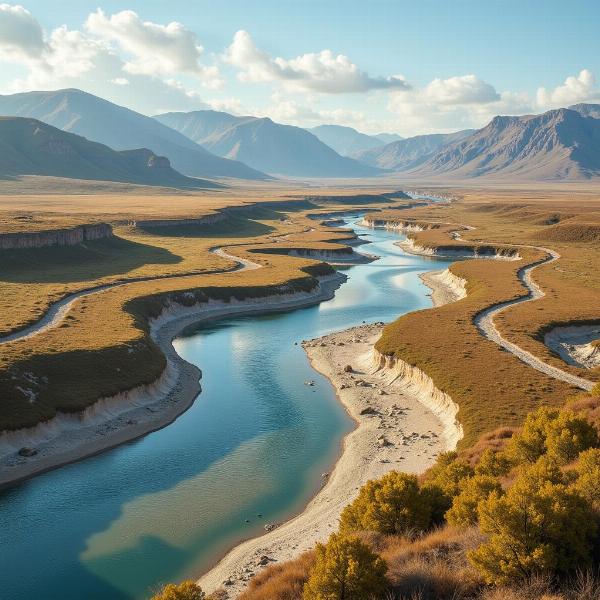Peneplain meaning in Hindi revolves around the concept of a nearly flat land surface. This term, important in geography, refers to a low-relief plain formed by extensive erosion over a very long period. Understanding its Hindi equivalent and the geological processes behind it is crucial for anyone studying the Earth’s surface.
What is a Peneplain? Exploring its Formation and Significance
A peneplain, almost a plain, is a landform created by the relentless forces of weathering and erosion. Imagine mountains slowly being worn down, rivers carving valleys, and the debris carried away over millennia. This process eventually results in a vast, relatively flat expanse, the peneplain. Understanding this concept is vital for comprehending landscape evolution and the impact of geological time. Its significance in geomorphology cannot be overstated, as it represents a stage in the Earth’s continuous transformation.
The term “peneplain” itself comes from “pene,” meaning “almost,” and “plain,” denoting a flat area. Thus, a peneplain is almost a plain, but not perfectly flat. Subtle variations in elevation and remnants of former hills, called monadnocks, might still exist. These monadnocks are harder rock formations that resisted the erosion process.
Peneplain Meaning in Hindi: Unearthing the Equivalent Term
The Hindi equivalent for peneplain is प्रायः समतल (prayah samtal). This term captures the essence of the landform, where “prayah” means “almost” or “nearly” and “samtal” means “flat” or “level.” This translation accurately reflects the definition of a peneplain – an almost flat surface formed through extensive erosion. Knowing this Hindi equivalent allows for a more nuanced understanding of the concept within the Indian geographical context.
Peneplain vs. Plateau: Understanding the Key Differences
While both peneplains and plateaus are elevated landforms with flat tops, they are formed through different geological processes. Plateaus are often formed by volcanic activity or tectonic uplift, resulting in a relatively sudden elevation of a large land area. Peneplains, on the other hand, are a product of slow and gradual erosion. This distinction is crucial in differentiating these two seemingly similar landforms. A key characteristic of peneplains is their gentle sloping nature, unlike the steeper sides often observed in plateaus.
Why is Knowing About Peneplains Important?
Understanding peneplains provides insights into the dynamic nature of Earth’s surface. It showcases the power of erosion over vast timescales and how even mighty mountains can be worn down to nearly flat surfaces. This knowledge is valuable for geologists, geographers, and anyone interested in the fascinating story of our planet.
 Peneplain and River Systems
Peneplain and River Systems
Conclusion: A Summary of Peneplain Meaning in Hindi
In conclusion, a peneplain, or प्रायः समतल (prayah samtal) in Hindi, is a nearly flat land surface formed through prolonged erosion. Its significance in understanding Earth’s geological history cannot be overstated. This article has explored the definition, formation, Hindi equivalent, and key differences from other landforms like plateaus. Hopefully, this has clarified the “peneplain meaning in Hindi” and enriched your understanding of this important geographical concept.
FAQ
- What is the literal translation of “peneplain” in Hindi? The literal translation is “prayah samtal,” meaning almost flat.
- How long does it take for a peneplain to form? Peneplain formation takes millions of years due to the slow process of erosion.
- Are peneplains perfectly flat? No, they are almost flat but can have subtle variations in elevation and remnants of hills (monadnocks).
- What is the difference between a peneplain and a plateau? Peneplains are formed by erosion, while plateaus are formed by uplift or volcanic activity.
- Why are peneplains important to study? Studying peneplains provides insights into Earth’s geological history and the power of erosion.
- Can you give an example of a peneplain in India? While definitive identification requires extensive geological study, some regions in the Deccan Plateau exhibit characteristics suggestive of peneplanation.
- Where can I find more information about peneplains? You can find more information in geography textbooks, online encyclopedias, and academic journals.
Meaning-Hindi.in offers professional translation services specializing in various fields, from business and legal documents to technical manuals and academic papers. We understand the nuances of Hindi and other languages, ensuring accurate and culturally sensitive translations. Our expert team can help you with all your translation needs, providing high-quality service tailored to your specific requirements. For a free quote, contact us at [email protected] or call us at +91 11-4502-7584. Let Meaning-Hindi.in bridge the language gap for you!